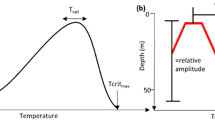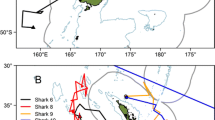Abstract
Acoustic telemetry was used to follow 22 blue sharks,Prionace glauca (Linnaeus), over the continental shelf and slope in the region between George's Bank and Cape Hatteras between 1979 and 1986. The sharks frequently made vertical excursions between the surface and depths of several hundred meters. The oscillations, which were repeated every few hours, were largest in the daytime and were smaller in amplitude and confined to depths near the thermocline at night. This behavior was prominent in trials from August through March, but was not seen from June through July. Diving is discussed in terms of a hunting tactic and behavioral thermoregulation. Most of the sharks moved in a southeasterly direction from the release point and many maintained a constant course day and night for several days. The sharks may orient to the earth's magnetic field, or to the ocean's electric fields, allowing them to swim on a constant heading in the absence of celestial cues. These possibilities are discussed in the appendix.
Similar content being viewed by others
Literature cited
Alerstam, T. (1987). Bird migration across a strong magnetic anomaly. J. exp. Biol. 130: 63–68
Carey, F. G., Gibson, Q. H. (1987). Blood flow in the muscle of free swimming fish. Physiol. Zoöl. 60: 138–139
Carey, F. G., Lawson, K. D. (1973). Temperature regulation in free-swimming bluefin tuna. Comp. Biochem. Physiol. 44A: 375–392
Carey, F. G., Robison, B. H. (1981). Daily patterns in the activities of swordfish,Xiphias gladius, observed by acoustic telemetry. Fish. Bull. U.S. 79: 277–292
Carey, F. G., Teal, J. M., Kanwisher, J. W. (1981). The visceral temperatures of mackerel sharks (Lamnidae). Physiol. Zoöl. 54: 334–344
Casey, J. G. (1985). Transatlantic migrations of the blue shark; A case history of cooperative shark tagging. In: Stroud, R. H. (ed.) World angling resources and challenges. Proc. 1st World Angling Conf., Cap d'Adge, France, 1984. Int. Gamefish Ass., Ft. Lauderdale, Florida p. 253–268
Gregg, M. C., Briscoe, M. G. (1979). Internal waves, fine-structure, microstructure and mixing in the ocean. Rev. Geophys. Space Phys. 17: 1542–1548
Kalmijn, A. J. (1978). Electric and magnetic sensory world of sharks, skates, and rays. In: Hodgson, E. S., Mathewson, R. F. (eds.). Sensory biology of sharks, skates and rays. U.S. Government Printing Office, Washington D.C., p. 507–528
Kalmijn, A. J. (1981). Biophysics of geomagnetic field detection. Trans. Inst. elect. electron. Engrs (Magnetics) 17: 1113–1124
Kalmijn, A. J. (1984). Theory of electromagnetic orientation: a further analysis. In: Bolis, L., Keynes, R. D., Maddrell, S. H. P. (eds.). Comparative physiology of sensory systems. Cambridge University Press, Cambridge, p. 525–560
Kalmijn, A. J. (1988). Electromagnetic orientation: a relativistic approach. In: O'Conner, M. E., Lovely, R. H. (eds.). Electromagnetic fields and neurobehavioral function. Alan R. Liss, New York, p. 23–45
Kirschvink, J. L., Dizon, A. E., Westphal, J. A. (1986) Evidence from strandings for geomagnetic sensitivity in cetaceans. J. exp. Biol. 120: 1–24
Kirschvink, J. L., Jones, D. S., MacFadden, B. J. (1985). Magnetite biomineralization and magnetoreception in organisms. A new biomagnetism. Plenum Press, New York
Klitgord, K. D., Behrendt, J. C. (1979). Basin structure of the U.S. Atlantic Margin. In: Watkins, J. S., Montadert, L., Dickerson, P. W. (eds.). Geological and geophysical investigations of continental margins. Am. Ass. Petrol. Geol. Mem. 29: 85–112
Kohler, N. E. (1987). Aspects of the feeding ecology of the blue shark,Prionace glauca in the Western North Atlantic. Ph.D. Thesis, University of Rhode Island, Department of Oceanography, Dissertation Abstracts No. AAD88-11 561
Kohler, N. E., Stillwell, C. E. (1981). Food habits of the blue shark,Prionace glauca, in the Northwest Atlantic. Int. Counc. Explor. Sea Comm. Meet. (Pelagic Fish Comm.) H: 61: 1–7
Landesman, J. G. (1984). Horizontal and vertical movements and seasonal population shifts in the blue shark,Prionace glauca, near Santa Catalina Island, California. Masters Thesis, California State University, Long Beach
Lawson, K. D., Carey, F. G. (1972). An acoustic telemetry system for transmitting body temperature from free-swimming fish. Unpublished Woods Hole Oceanogr. Inst. Techn. Rept WHOI 71–67
Nelson, D. R. (1990). Telemetry studies of sharks: a review with, applications in resource management. In: Pratt, H. L. Jr, Gruber, S. H., Taniuchi, T. (eds.). Elasmobranchs as living resources: recent advances in fisheries biology, ecology, life history, captive biology and systematics. Proc. 2nd USA — Japan elasmobranch conference held 9 to 14 Dec., 1987 at the East-West Center, Honolulu, Hawaii. U.S. Department of Commerce, NOAA-NMFS, NOAA Technical Report NMFS 90, US Government Printing Office, Washington, D.C., p. 245–262.
Olson, D. B., Schmitt, R. W., Kennelly, M., Joyce, T. M. (1985). A two-layer diagnostic model of the long-term physical evolution of warm-core ring 82-B. J geophys. Res. 90: 8813–8822
Pratt, H. L., Jr (1978). Reproduction in the blue shark,Prionace glauca. Fish. Bull. U.S. 77: 445–470
Roper, C. F. E., Young, R. E. (1975) Vertical distribution of pelagic cephalopods. Smithson. Contr. Zoöl. 209: 1–51
Sasaki, T. (1964). On the instruments for measuring angular distributions of underwater daylight intensity. In: Tyler, J. E. (ed.) Physical aspects of light in the sea: a symposium. University of Hawaii Press, Honolulu, p. 19–24
Sharold, J. V. (1989). Swimming behavior of sharks. Doctoral dissertation. MIT. — Woods Hole Oceanographic Inst., Tech. Rep. WHOI-89-2. NTIS No PB 89-198212/AS
Sciarrotta, T. C., Nelson, D. R. (1977) Diel behavior of the blue shark,Prionace glauca, near Santa Catalina Island, California. Fish. Bull. U.S. 75: 519–528
Stevens, J. D. (1973). Stomach contents of the blue shark (Prionace glauca) off Southwest England. J. mar. biol. Asso. U.K. 53: 357–361
Towne, W. F., Gould, J. L. (1985). Magnetic field sensitivity in honeybees. In: Kirschvink, J. L., Jones, D. S., MacFadden, B. J. (eds.) Magnetite biomineralization and magnetoreception in organisms. A new biomagnetism. Plenum Press, New York, p. 385–407
Tricas, T. C. (1978). Relationships of the blue shark,Prionace glauca, and its prey species near Santa Catalina Island, California. Fish. Bull. U.S. 77: 175–182
Walcott, C. (1978). Anomalies in the earth's magnetic field increase the scatter of pigeons' vanishing bearings. In: Schmidt-Koenig, K., Keeton, W. T. (eds.) Animal migration, navigation and homing. Springer Verlag, Berlin, p. 347–353
Walker, M. M., Bitterman, M. E. (1985). Conditioned responding to magnetic fields by honeybees. J. Comp. Physiol. (Sect. A) 157: 7–71
Weihs, D. (1973). Mechanically efficient swimming techniques for fish with negative buoyancy. J. mar. Res. 31: 194–209
Wiltschko, W. (1983) Compasses used by birds. Comp. Biochem. Physiol. 76A: 709–717
Literature cited
Kalmijn, A. J. (1974). The detection of electric fields from inanimate and animate sources other than electric organs. In: Fessard, A. (ed.) Handbook of sensory physiology, Vol. III/3. Springer Verlag, Berlin, Heidelberg, New York, p. 147–200
Kalmijn, A. J. (1978). Electric and magnetic sensory world of sharks, skates and rays. In: Hodgson, E. S., Mathewson, R. R. (eds.) Sensory biology of sharks, skates, and rays. U.S. Government Printing Office, Washington, D.C., p. 507–528
Kalmijn, A. J. (1981). Biophysics of geomagnetic field detection. Trans. Inst. elect. electron. Engrs (Magnetics) 17: 1113–1124
Kalmijn, A. J. (1982). Electric and magnetic field detection in elasmobranch fishes. Science, N.Y. 218: 916–918
Kalmijn, A. J. (1984). Theory of electromagnetic orientation: a further analysis. In: Bolis, L., Keynes, R. D., Maddrell, S. H. P. (eds.) Comparative physiology of sensory systems. Cambridge University Press, Cambridge, London, New York, p. 525–560
Kalmijn, A. J. (1988). Detection of weak electric fields. In: Atema, J., Popper, A. M., Fay, R. R., Tavolga, W. N. (eds.) Sensory biology of aquatic vertebrates. Springer Verlag, Berlin, Heidelberg, New York, p. 151–186
Longuet-Higgins, M. S., Stern, M. E., Stommel, H. (1954). The electrical field induced by ocean currents and waves, with applications to the method of towed electrodes. Pap. phys. Oceanogr. Met. 13: 1–37
Sandford, T. B. (1967). Measurement and interpretation of motional electric fields in the sea. Doctoral thesis, Massachusetts Institute of Technology, Cambridge
Von Arx, W. S. (1974). An introduction to physical oceanography. Adison-Wesley, Reading, London
Author information
Authors and Affiliations
Additional information
Communicated by O. Kinne, Oldendorf/Luhe
Rights and permissions
About this article
Cite this article
Carey, F.G., Scharold, J.V. & Kalmijn, A.J. Movements of blue sharks (Prionace glauca) in depth and course. Mar. Biol. 106, 329–342 (1990). https://doi.org/10.1007/BF01344309
Accepted:
Issue Date:
DOI: https://doi.org/10.1007/BF01344309




